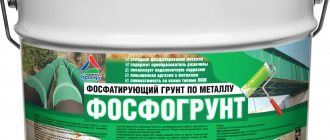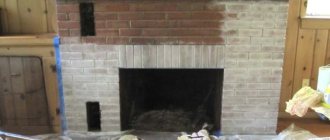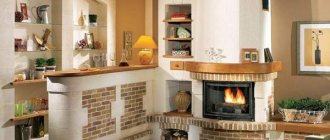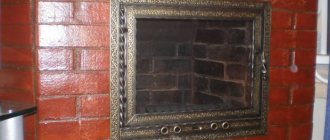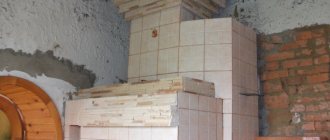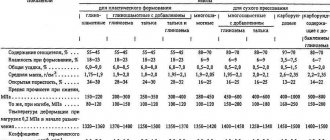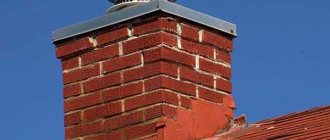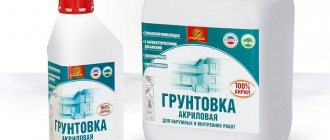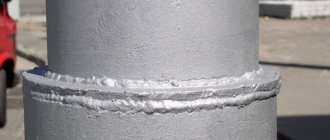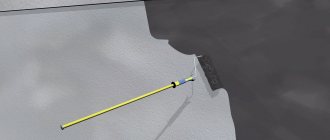Purpose of primer compositions
The need for a heat-resistant primer for metal is not obvious to everyone. Many people have the opinion that it is enough to paint or simply varnish newly manufactured metal structures.
Experience shows that the paint layer does not adhere well to the metal, despite the high consumption of funds, and quickly begins to peel and crumble.
Heat-resistant primer for metal performs several important functions:
- increases the adhesion of paints and varnishes during subsequent application;
- prevents the formation of oxide products;
- reduces paint consumption due to reduced absorption by the surface;
- forms a dense, durable protective layer that is resistant to thermal influences.
Applying primer impregnation will significantly save financial investments in giving a beautiful appearance to the heated metal and ensuring its preservation for a long time.
Temperature standards
Heat-resistant soils have special compositions adapted to strictly defined conditions. When choosing a product, you need to have an accurate idea of the planned thermal load regime and take an interest in the manufacturers’ recommendations displayed on the labels.
Heat-resistant primer is available for use in the following temperature ranges:
- from room temperature to 60 °C;
- no more than 100 °C;
- up to 300 °C;
- more than 300 °C.
Products of the first group are used for water heating systems in apartments or houses; the second - for steam systems, fireplaces, external surfaces of stoves.
For powerful household heaters and industrial installations operated in harsh conditions, soils with higher fire-retardant properties are intended.
GF-031
The letter combination in the labeling clearly indicates that the product belongs to the glypthal group.
The description confirms the presence in the primer of this brand of glyphthalic resin with a solvent, pigment particles, antioxidant stabilizers, and substances with an active surface.
Metal products made of aluminum magnesium alloys and steels after applying the GF-031 coating can withstand heating up to 200 °C without any unpleasant consequences.
Before applying the GF heat-resistant primer to a metal structure, the suspension should be diluted with a solvent (solvent) to obtain a liquid with the required viscosity. With proper dilution and application, the layer thickness after the first coating will reach 20 microns, the second - 40 microns.
Phosphorus-based products
Soils containing a phosphorus component have half a century of experience in use and remain popular today. They contain a solution of orthophosphoric acid in alcohol mixed with pigments, resins and organic solvents.
Fire retardant primer based on phosphates, exhibits stability under thermal influences not exceeding 300 °C.
The heat-resistant product is intended for processing structures made of aluminum, titanium, magnesium alloys, and all types of steel.
The manufacturer assures that it is possible to apply the drug both to freshly manufactured parts and to products with a layer of corrosive products reaching 70 microns. However, despite the good fixation of the solution on the oxidized surface, it still makes sense to clean it first.
Phosphorus-containing primers can be easily polished and coated with any type of paint and varnish product. The composition has a wide range of applications; it can be used to process:
- building structures made of metals;
- roofs;
- hangars;
- pipelines;
- bridge spans and supports;
- overpasses;
- platforms.
Any metal product, after applying a heat-resistant layer of phosphate primer, can withstand both heating and the aggressive influence of the surrounding space.
For household and industrial metal products exposed to very high heat, a heat-resistant primer for ovens with the designation G-77, which can withstand temperatures up to 1200 °C, is ideal.
Varieties of modern heat-resistant primers
Modern heat-resistant mass for stoves and fireplaces is very diverse, therefore, as an example, we will consider the most popular and widespread samples.
- GF – 031
This primer is a suspension of dyes with antioxidants, as well as surfactants in glyphthalic varnish.
This mass is used for processing steel, magnesium and aluminum. Very often, GF-031 is used in the civil aircraft industry as a finishing material for aircraft bodies.
The highest permissible temperature threshold is up to 200°C.
The solvent for such soil is a solvent. Solvent can also be used to dilute the mass when it thickens.
The primer is applied by spraying using hand-held painting equipment.
The recommended thickness of one coating layer should not exceed 20 microns. With this coating density, the material consumption is about 80 g/m2.
According to standards, the mass is produced in yellow color.
- Phosphosoil
As some may have already guessed, now we will talk about a phosphating primer, which reacts with the base coat and forms a thin layer of insoluble phosphate, which increases the level of adhesion and does not allow corrosion to cover the surface.
The composition of the phosphating primer is given in the table.
| Ingredients | Concentrate | Diluted substance (in proportion 1:2) | Prototype |
| Phosphoric acid (g/l) | 200-240 | 70-100 | 70-100 |
| Zinc oxide (g/l) | 45-60 | 15-20 | 15-20 |
| Sodium nitrate (g/l) | 8-12 | 4-6 | 2-3 |
| Chromium trioxide (g/l) | 1,2-2,4 | 0,6-1,2 | 0,3-0,6 |
| Alcohol (g/l) | — | — | 60-150 |
| Water | rest | rest | rest |
The binder is a mixture of acrylic, formaldehyde and epoxy resin. Based on this composition of binders, it is not difficult to guess that the composition can only be used outdoors or in industrial conditions.
The permissible operating temperature threshold is up to 300°C.
Due to its unique composition, the primer can be used with any type of heat-resistant and conventional paints and varnishes. The mass can be used not only for work on metal surfaces. The manufacturer allows it to be used to increase the level of adhesion of final finishing on fiberglass and ceramics. The mass can be applied both to a previously prepared surface and to rust.
Following the advice of experienced finishers, it is still better to clean off the rust, at least the one that has formed layers on the surface of the product.
Acetone or toluene can be used as a diluent for such soil.
Due to the fact that the substance contains organic solvents, it can be applied to the surface even at sub-zero temperatures (down to -10°C). One layer of soil dries in half an hour at a temperature of 20°C.
Material consumption is about 90 g/m2.
- G – 77
This primer for stoves and fireplaces is stunning in terms of its heat resistance. For such a mass, the manufacturer stated a threshold operating temperature of 1200°C, which is very intriguing compared to the other options considered.
Distributors do not disclose the composition of the water-dispersion primer, but such amazing heat resistance makes one wonder whether heat-resistant silicone acts as a bonding agent?
AU-1417 R
Alkyd-based varnish with a urethane component, including pigments, converters of rust products, is characterized by maximum ease of use; desiccant reagents that provide rapid drying and solvents.
The reagent does not belong to the category of classical primers because it immediately forms a final coating that does not require subsequent painting.
The product is available in a color palette corresponding to the international scale; can be used to protect all types of ferrous metal products. Its heat resistance is limited to +60°.
How to choose the right one
To make a successful purchase of a heat-resistant primer, you should prepare. It is necessary to find out the composition of the metal alloy that is planned to be processed; consider the maximum possible thermal loads during operation; compare allowable financial expenses with the cost of funds.
It is absolutely not necessary to use multifunctional compounds if the metal surface does not contain oxidized inclusions and the decorative qualities of the products will not be visible.
Situations are very likely when only metal fragments, for example a stove or fireplace, need to be primed, and then it is planned to do its full cladding.
In this case, heat-resistant properties are more important than decorative ones. It is always a good idea to discuss your intentions with competent representatives of the supplier company. The consultant’s opinion does not have to be decisive, but it is worth listening and taking it into account.
Why use a heat-resistant primer?
Is it really necessary to prime a surface that will subsequently heat up? To answer the question posed, it is necessary to understand the operating features of such items. Here are a few of them that are the most obvious:
- The need to increase the adhesion of the dye to the surface. It's no secret that many primer compositions have a fairly high degree of adhesion. In addition to this, they increase the adhesive characteristics of the surface being painted. It is thanks to the primer composition that metal elements that can be heated acquire a certain film that is resistant to dissolution when a metal coloring agent is applied to it.
- Protection against corrosion damage. Heat-resistant primer compositions are not only necessary in terms of preparing the surface for paint application, but also act as a protective material themselves.
- Reducing paint consumption. After applying a heat-resistant primer, a kind of film appears on the product. When painting a surface with coloring compounds, the absorption process is almost completely absent, which ensures economical paint consumption. This property is relevant when finishing stoves or fireplaces. The fact is that painting compositions of this type are quite expensive. Therefore, it is better to carry out high-quality priming than to spend money on paint.
Is surface preparation necessary?
A wide variety of types of products are subject to treatment with a heat-resistant primer, some of which may have been manufactured on the eve of treatment, others have already been in storage for some time or even in use.
This should be taken into account when assessing the need for preliminary surface preparation. Newly made products do not need to be particularly cleaned.
Products from the warehouse may have been exposed to a humid environment, resulting in corrosion. Stored metal products become contaminated with particles of dust and other impurities. In any case, you need to carry out at least a rough cleaning, sweep away or remove all debris with an air stream.
It is useful to delve into the recommendations of the manufacturer of the heat-resistant primer. It is very likely that the metal will have to be cleaned with a rough brush or abrasive materials with large grains. A high-quality primer, when applied correctly, will provide reliable protection for the metal.
The brick oven is built on clay mortar. Will be painted with heat resistant paint. The clay mortar must be strengthened with a primer before grazing. A review of construction hypers did not reveal the presence of heat-resistant soils.
A search on the Internet gives several names, even the manufacturer of heat-resistant paint indicates its primer, but there is no way to go in and buy it.
Who treated stoves and fireplaces with what? In addition to strengthening the base, I also want the absence of discharge and odor on a hot stove.
Just acrylic primer and acrylic paint. Won't they fit? Your oven should not heat up more than 60 degrees. This is how acrylic holds such temperatures.
The threshold temperature limit for “spoilage” is one thing, but the presence of substances that begin to pass into the air as the temperature increases is another. We need a recommendation for a primer that, after drying, completely eliminates the emission of anything into the environment when the temperature rises.
If the paint contains/is based on organosilicon, then prime it with diluted liquid glass, IMHO. Or easier, make 1 layer with paint diluted by 10 percent.
Leon wrote: The temperature threshold for “spoilage” is one thing, but the presence of substances that begin to pass into the air as the temperature increases is another. We need a recommendation for a primer that, after drying, completely eliminates the emission of anything into the environment when the temperature rises.
There are two factors here: heating temperature and heat resistance of the coating. (the term heat resistance in this case is incorrect - the temperatures are not the same). So, after drying, the primer is in the state of a polymer film. “Everything” that can be inside is in a dried state. Volatile organic compounds (VOC) were released during drying and polymerization. There should be no smell left. When heated to a certain temperature, the polymer retains its properties and does not collapse. Nothing comes out of it, then the polymer begins to collapse, the transverse then longitudinal cross-links are destroyed (the film becomes soft), then cracking begins, then charring. For household primers, manufacturers do not indicate temperature limits for such destruction. Since it is understood that the operating temperature range for outdoor work is from minus 40 to plus 50 Celsius. If the material behaves well in this range, then there is nothing to worry about. Specialized materials designed for elevated temperatures contain in the description information on the temperature range of operation or simply the maximum temperature. Sometimes the operating temperature and temp are also given. short-term heating.
What can surface priming achieve?
The use of primer as a base coat for fireplaces and stoves has the following purposes:
- to increase the level of adhesion of putty and plaster;
- to strengthen the base (the resins that are part of the substance penetrate deep into the pores and bind the topcoat and the base into one).
Please note that at high operating temperatures you need to forget about using ordinary gypsum or cement masses. To decorate the stoves, you need a mixture based on clay, sand, and sometimes skim milk can be a bonding component.
Yes, yes, you didn’t think so, exactly milk! Due to the presence of casein (milk protein), when denatured at high temperatures, the solution will retain its remarkable binding properties.
For each buyer, the manufacturer indicated the following information on the packaging:
- how can the substance be applied to the surface (with a roller or brush);
- gave recommendations on the number of layers (preferably no more than 2);
- indicated the time during which the coating can dry (no more than 60 minutes);
- gave an approximate soil consumption (no more than 400 ml/m2).
Source: pootdelke.ru
Temperature ranges
At what temperature is the use of special, heat-resistant primers required? Let's analyze the coating requirements at different operating temperatures.
Up to 60C
In particular, elements of autonomous heating systems fit into this temperature range. Their typical temperature difference between supply and return is 70/50C, which gives no more than +60C on the surface of the heating devices.
At temperatures from 0 to +60 you can safely use general purpose paints and primers. If the painting technology is followed (that is, if the surface is cleaned well and the primer matches the type of paint and varnish material), there is no need to worry about paint delamination or fading.
General purpose paints can be used in an autonomous heating circuit.
Up to 100C
The only significant difference from the previous scenario is the need to use paints with persistent pigments. The binder and primer remain the same as before: all popular types of paint can withstand prolonged heating without destruction.
Practical consequence: cheap and very common GF-021 is a completely suitable primer for radiators both in autonomous heating circuits and in central heating systems.
Up to 300C
And here comes the high point of heat-resistant soils. If the instructions for using a temperature-resistant coating indicate the need for priming, you will have to select special compounds that can withstand prolonged heating and retain their properties over the entire range of operating temperatures.
Over 300C
All paints intended for temperatures above +300 degrees are applied without prior priming, directly onto a cleaned and degreased surface. A layer of soil at such temperatures will only increase the likelihood of the coating peeling off.
Permissible temperatures
Are you wondering at what maximum temperature a heat-resistant primer is needed? Let's analyze the requirements that are put forward for coatings at different operating temperatures.
- Up to 60oC
As a rule, autonomous heating is installed at this temperature. Their usual temperature fluctuations are 70/50°C, which on the device itself does not exceed the permissible 60°C.
With this indicator, you can safely use ordinary finishing materials. If repair work is carried out correctly, you don’t have to worry about delamination or fading of paint and varnish materials.
- Up to 100oC
Conventional materials are also suitable for this temperature, but there is one small feature: you need to use paint with a durable pigment. The binder and solution will be the same as at 60°C.
- Up to 300oC
But at such temperatures you already need to think about heat-resistant soil. If the instructions for heat-resistant paints and varnishes indicate the need to apply primer, you will need to rack your brains about purchasing a specialized composition that can easily cope with prolonged heating and will retain its properties when the equipment is heated to maximum.
- More than 300oC
All paints and varnishes that are applied to equipment whose operation occurs at temperatures exceeding 300°C do not require the use of primer. At such an operating temperature, the primer can only aggravate the situation and peeling of the coating cannot be avoided.
Analysis of market offers
What are heat-resistant soils? Let's take a look at several offers on the modern market as examples.
GF-031
Alkyd heat-resistant primer is produced according to TU-2312-030-00206919-2002 and is a suspension of pigments, antioxidants and surfactants in glyphthalic varnish.
What can you tell about its properties and features?
- The primer is intended for steel, magnesium and aluminum surfaces. In particular, GF-031 is used in civil aviation - for applying coatings to aircraft bodies.
- The maximum operating temperature is +200C.
It’s interesting: the reservation about civil aircraft construction is not accidental. The outer skin of an interceptor fighter at a speed of about 2.5M (2.5 times faster than the speed of sound) due to friction with the air heats up to 300-500 degrees.
- Solvent - solvent; It is also used to dilute the soil when it thickens.
- Application method: spray or using a hand-held painting tool.
- The thickness of the single-layer coating after drying should be 15-20 microns. Primer consumption per layer is 60-80 g/m2.
- TU specifies the color of the pigments used. Produced according to technical specifications GF-031 - yellow.
Phosphosoil
The name is a trademark of the Moscow company KrasKo. As you might guess, we have the so-called phosphating primer.
It reacts with the base and forms a thin layer of insoluble phosphates that improve adhesion and prevent corrosion.
Chemical composition of the phosphating reagent.
- A mixture of acrylic, formaldehyde and epoxy resins is used as a binder. It is logical to assume that the primer is intended exclusively for open air or industrial conditions: formaldehyde in a residential area will clearly be unnecessary.
- Operating temperature range - up to +300 degrees.
- Thanks to its composition, the primer can be used with any type of heat-resistant and conventional paints. It can be used not only on metal: the manufacturer allows it to be used to improve the adhesion of the final coating on fiberglass or ceramics.
- The primer can be applied not only to a previously cleaned surface, but also to a rusty surface.
However: when applying a primer with your own hands, it is still worth first removing sheet and loose rust. The phosphating composition can change its chemical properties, but it will not change the spatial structure of the fragile oxide.
- Phosphosoil is diluted with acetone or toluene.
- Thanks to organic solvents, the composition can be applied at low temperatures down to -10C. Drying time for a single-layer coating at +20 is no more than 30 minutes.
- The average primer consumption is 70-90 grams per square meter.
The photo shows the packaging of Phosphogrunt.
This heat-resistant primer for stoves and fireplaces impresses with its heat resistance. Its stated operating temperature is 1200 degrees, which, you see, is very impressive compared to the previously described solutions. The composition of the water-dispersed primer is not disclosed by dealers; however, the colossal heat resistance suggests that the main binder in G-77 is heat-resistant silicone.
Applying primer has two purposes:
- Improving the adhesion of putties and plasters.
Useful: at high operating temperatures, you can forget about the usual gypsum and cement mixtures. A mixture of clay and sand is used to decorate stoves and fireplaces; Often, skim milk is added as a binder: the casein contained in it (milk protein, also known as low-fat cottage cheese) retains excellent binding properties even with temperature denaturation.
Plastering the stove with clay mortar.
- Strengthening the foundation . The resins contained in the soil penetrate its pores and bind the surface layer of the material into a single whole.
What other information about primer is available to a potential buyer?
- Application is quite traditional - with a roller or brush in two layers.
- Drying time for one layer is no more than an hour. At least two hours must pass before further finishing begins on the primed surface.
- Priming is performed at positive temperatures. Water based, remember?
- Consumption is no more than 400 milliliters of soil per square meter of surface.
Heat-resistant penetrating G-77 is supplied in plastic canisters of 1 kilogram.
How to prepare the solution
If the choice is made in favor of clay and sand, then before work it is important to study all the intricacies of preparation. Particular attention should be paid to the ratio of ingredients: the quality of the future coating depends on this.
Before you start cooking, you need to consider the following points:
- It is better to soak the clay in advance, at least three days in advance. Then it will absorb a certain amount of water, swell and be ready for kneading.
- Before use, sand should be sifted through a fine mesh - this will help clear it of debris and foreign inclusions. In addition, excess moisture will not disrupt the proportions of the mixture if the sand is pre-dried.
We suggest you read: How and with what to plaster a brick stove
After all the preparatory activities, you can proceed to mixing.
Composition and proportions
There are several variations of the plaster composition:
- Clay, sand, asbestos (1:2:0.1).
- Clay, sand, asbestos, lime (1:2:0,1:1).
- Clay, sand, asbestos, cement (1:2:0,1:1).
- Clay, sand, asbestos, lime, gypsum (1:1:0,2:2:1).
- Clay, sand, asbestos, lime (1:1:0,2:2).
- Sand, asbestos, lime, gypsum (1:0,1:2:1).
Before you get started, you can do a little test. Experts advise preparing several types of solution, forming small balls, and when they dry, dropping them from a small height. It is worth using the recipe for the solution from which the ball that remained intact was made.
Preparing the mixture
It is best to mix the ingredients this way:
- The required amount of pre-soaked clay is placed in a special container.
- Next, in accordance with the selected recipe, sifted sand and other ingredients are added.
- It is better to use a construction mixer for kneading - then the mass will be more homogeneous than when kneading by hand.
- The last stage is dilution with water until the required consistency is obtained. Do not forget that a certain thickness must be maintained for each layer.
- Immediately after mixing, the solution must be put into use. Otherwise, it will thicken, and then crack and may crumble.
